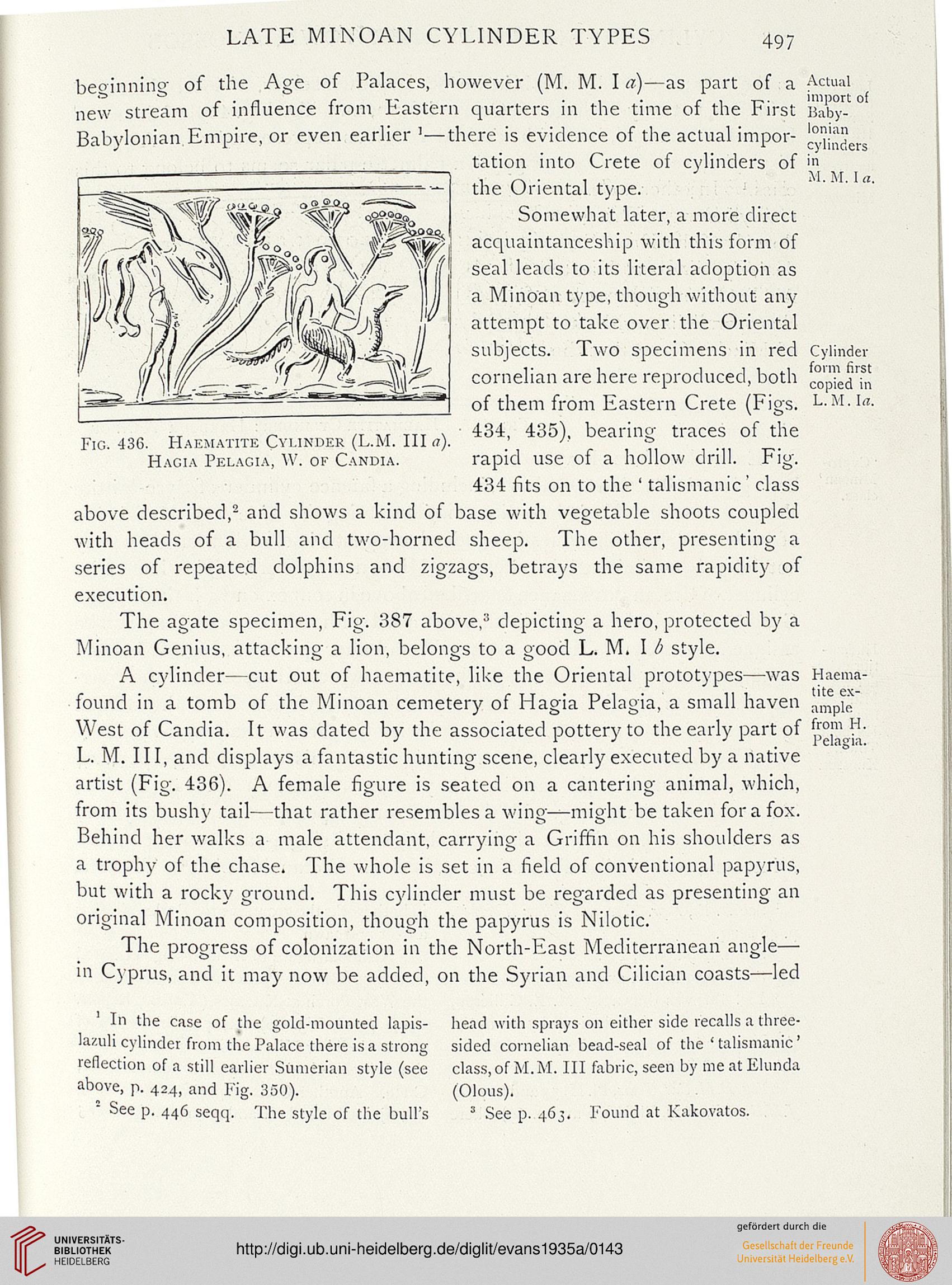LATE MINOAN CYLINDER TYPES
497
Fig. 436. Haematite Cylinder (L.M. Ill a).
Hagia Pelagia, W. of Candia.
beoinnirig of the Age of Palaces, however (M. M. I a)—as part of a
new stream of influence from Eastern quarters in the time of the First
Babylonian Empire, or even earlier '—there is evidence of the actual impor-
tation into Crete of cylinders of
the Oriental type.
Somewhat later, a more direct
acquaintanceship with this form of
seal leads to its literal adoption as
a Minoan type, though without any
attempt to take over the Oriental
subjects. Two specimens in red
cornelian are here reproduced, both
of them from Eastern Crete (Figs.
434, 435), bearing traces of the
rapid use of a hollow drill. Fig.
434 fits on to the ' talismanic' class
above described,2 and shows a kind of base with vegetable shoots coupled
with heads of a bull and two-horned sheep. The other, presenting a
series of repeated dolphins and zigzags, betrays the same rapidity of
execution.
The agate specimen, Fig. 387 above,3 depicting a hero, protected by a
Minoan Genius, attacking a lion, belongs to a good L. M. I /; style.
A cylinder—cut out of haematite, like the Oriental prototypes—was
found in a tomb of the Minoan cemetery of Hagia Pelagia, a small haven
West of Candia. It was dated by the associated pottery to the early part of
L. M. Ill, and displays a fantastic hunting scene, clearly executed by a native
artist (Fig. 436). A female figure is seated on a cantering animal, which,
from its bushy tail—that rather resembles a wing—might be taken for a fox.
Behind her walks a male attendant, carrying a Griffin on his shoulders as
a trophy of the chase. The whole is set in a field of conventional papyrus,
but with a rocky ground. This cylinder must be regarded as presenting an
original Minoan composition, though the papyrus is Nilotic
The progress of colonization in the North-East Mediterranean angle—
m Cyprus, and it may now be added, on the Syrian and Cilician coasts—led
Actual
import of
Baby-
lonian
cylinders
in
M.M. la.
Cylinder
form first
copied in
L.M. la
Haema-
tite ex-
ample
from H.
Pelagia.
In the case of the gold-mounted lapis-
lazuli cylinder from the Palace there is a strong
reflection of a still earlier Sumerian style (sec
above, p. 424, and Fig. 350).
" See p. 446 seqq. The style of the bull's
head with sprays on either side recalls a three-
sided cornelian bead-seal of the 'talismanic'
class, of M. M. Ill fabric, seen by me at Elunda
(Olous).
3 See p. 463. Found at Kako.vatos.
497
Fig. 436. Haematite Cylinder (L.M. Ill a).
Hagia Pelagia, W. of Candia.
beoinnirig of the Age of Palaces, however (M. M. I a)—as part of a
new stream of influence from Eastern quarters in the time of the First
Babylonian Empire, or even earlier '—there is evidence of the actual impor-
tation into Crete of cylinders of
the Oriental type.
Somewhat later, a more direct
acquaintanceship with this form of
seal leads to its literal adoption as
a Minoan type, though without any
attempt to take over the Oriental
subjects. Two specimens in red
cornelian are here reproduced, both
of them from Eastern Crete (Figs.
434, 435), bearing traces of the
rapid use of a hollow drill. Fig.
434 fits on to the ' talismanic' class
above described,2 and shows a kind of base with vegetable shoots coupled
with heads of a bull and two-horned sheep. The other, presenting a
series of repeated dolphins and zigzags, betrays the same rapidity of
execution.
The agate specimen, Fig. 387 above,3 depicting a hero, protected by a
Minoan Genius, attacking a lion, belongs to a good L. M. I /; style.
A cylinder—cut out of haematite, like the Oriental prototypes—was
found in a tomb of the Minoan cemetery of Hagia Pelagia, a small haven
West of Candia. It was dated by the associated pottery to the early part of
L. M. Ill, and displays a fantastic hunting scene, clearly executed by a native
artist (Fig. 436). A female figure is seated on a cantering animal, which,
from its bushy tail—that rather resembles a wing—might be taken for a fox.
Behind her walks a male attendant, carrying a Griffin on his shoulders as
a trophy of the chase. The whole is set in a field of conventional papyrus,
but with a rocky ground. This cylinder must be regarded as presenting an
original Minoan composition, though the papyrus is Nilotic
The progress of colonization in the North-East Mediterranean angle—
m Cyprus, and it may now be added, on the Syrian and Cilician coasts—led
Actual
import of
Baby-
lonian
cylinders
in
M.M. la.
Cylinder
form first
copied in
L.M. la
Haema-
tite ex-
ample
from H.
Pelagia.
In the case of the gold-mounted lapis-
lazuli cylinder from the Palace there is a strong
reflection of a still earlier Sumerian style (sec
above, p. 424, and Fig. 350).
" See p. 446 seqq. The style of the bull's
head with sprays on either side recalls a three-
sided cornelian bead-seal of the 'talismanic'
class, of M. M. Ill fabric, seen by me at Elunda
(Olous).
3 See p. 463. Found at Kako.vatos.





